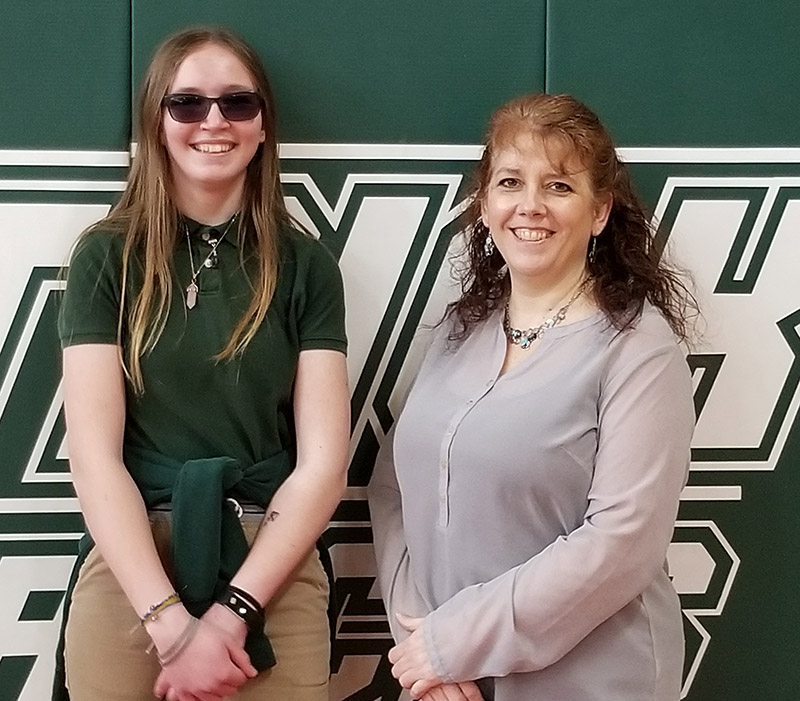
Megan Cook, an eighth-grader at St. Patrick Catholic School in Hudson, won a contest for her innovative approach of using solar power to produce clean drinking water. Here, she stands with her science teacher, Julie Mattimiro. (Submitted photo)
Joe Winter
Special to the Catholic Herald
A little extra credit can go a long way, even if it means your teacher has to revamp her science curriculum.
Megan Cook has captured for her Catholic school, St. Patrick’s in Hudson, a $1,000 science, technology, engineering and math (STEM) award, and for her class, a trip to Minnesota Rubber and Plastics’ new multimillion-dollar facility for a rare engineer-for-a-day encounter with top professionals.
Upon hearing about a contest to find solutions for problems from her science teacher, the eighth-grader quickly put her mind to work, creating a list of potential topics for the Young Innovators contest sponsored by Minnesota Rubbers and Plastics.
She needed a new idea and came up with several that needed extensive research. She then checked multiple sources online to ensure their originality. After paring down her list of ideas, Cook settled on a treatise on cleaning water with solar power and in an even more innovative faucet using hydrophobic filters.
Cook was addressing a major problem. Hundreds of millions of people don’t have the availability of even a few ounces of water – and not just for safe drinking, but other things people take for granted, such as nonpolluted water for washing dishes, bathing or even flushing the toilet.
Construction on Minnesota Rubber and Plastics’ $7 million Innovation Center is scheduled to be completed in May. Upon its completion, Cook and the dozen students in her class will trek to Plymouth, Minnesota, on the other side of the Twin Cities, for a daylong crash course. They will learn, among other things, methods to respect God’s creation by preserving it during a day with some of the industry’s top materials scientists and engineers.
Cook and her teacher are working with others at the school to ensure their classrooms are stocked with essential supplies for studying science and other subjects, before finding other uses for the STEM-centered funds.
Julie Mattimiro, Cook’s science teacher, was told about the contest by a colleague. It didn’t fit into the curriculum at the time, so she posed it to her students as extra credit.
Doing extra coursework is something characteristic of Cook, Mattimiro said.
As a result of Cook’s success, this will be one of the first field trips for students since COVID-19 suspended outings.
“I think the most interesting fact that I found was that 784 million people do not have access to clean water,” Cook said. “To gather my information I just used my computer, found different facts, and then checked to make sure those facts were correct.”
Mattimiro noted that one in three people on the planet do not have access to water fit for drinking, which underscores the importance of Cook’s endeavor.
Her fact-checking was extensive, as originally Cook had a full page of ideas, but then went online and used many different searches to eliminate things that were already created, or just didn’t appeal to her anymore, she said. “Eventually I had four ideas left, and that is when I asked my teachers and family members for advice.
When every person I asked said the solar power water is cleaner, I knew it was the right thing to do.”
She said her idea fits into stewardship of the earth.
“When I was doing this project I was just thinking about the people that needed help, not necessarily about religion, but what my religion has taught me.”
Cook’s paper was titled,” Solar Power Solution to Make Contaminated Water Drinkable.”
The committee of judges was impressed with the “thoughtful, detailed and creative entries” received for the Young Innovators contest,” Karthik Viswanathan, vice president of product development at Minnesota Rubber and Plastics, said in a press release announcing Cook’s award.
“We ultimately chose Megan’s entry for its thorough research, innovation, practicality and the creative way she came up with a solution to a major problem facing millions of people across the world. It also specifically addresses environmental sustainability and water quality, which are two issues of importance for MRP.”
When Cook completed outlining her idea, the proposal was concise enough that it didn’t quite meet the required word limit. So she did additional research that highlighted the importance of the topic.
Cook’s win was announced to classmates and teachers on a St. Patrick’s school news broadcast. They would need to help her determine how to spend the monetary award on STEM supplies.
“The entire faculty and I are extremely proud of Megan for this accomplishment,” said Mattimiro, who teaches earth sciences.
The sponsoring company creates elastomeric and thermoplastic components and has customers across multiple continents. Part of their objective in solving what it calls “the industry’s toughest problems” for more than 76 years has been looking for ideas for new products. Just like Cook’s.
